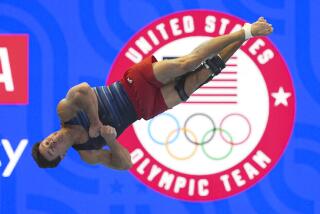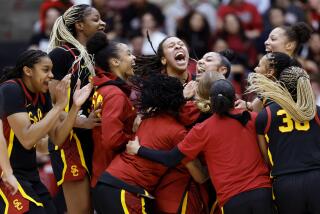Waiting for His Bar Exam : Stanford’s Adamek Working His Way Back After Severe Injury
- Share via
Several spectators told Shawn Adamek that they heard his arm snap from across the Monroe High gym. Apparently, that was supposed to assuage him, as if the injury was so gruesome he had a right to be scared. Should he never return to gymnastics, they would understand.
It would have shocked those fans to see Adamek a year later competing for Stanford.
“I thought (the broken arm) could be the end of his career,” Monroe Coach Les Sasvary said. “But he has terrific willpower and he bounced back. The thing is that Shawn is hungry, and at the time the injury happened he had not proved anything to himself on the collegiate level, so it was a tremendous motivating factor to him.”
A recovered Adamek competed in the Pacific 10 Conference tournament in March. The Cardinal was attempting to wrest the title from UCLA, a national power.
“We were winning halfway through the meet, and I had two events left. . . . I was getting nervous thinking, ‘Oh, my gosh, my score is going to count now,’ ” said Adamek, who had competed in only one meet before the conference championship. “I found that I actually did well under pressure. I had a good meet. Even though I didn’t score really high, I scored well . . . (9.35 on the pommel horse and 9.25 in the vault) and I did what I had to do.”
For Adamek to accomplish that much, he needed persistence, patience and courage. Dropping gymnastics and assuming the life of an average Stanford student, especially after two operations to repair his injured arm, would have seemed a reasonable choice for Adamek.
“It was a very frustrating injury for him,” Stanford Coach Sadao Hamada said. “But he came back and helped our team a great deal.”
Adamek’s frustrations began March 30, 1989, while he warmed up for the high bar competition against University High. A leather grip on Adamek’s right hand caught on the bar as he continued to spin. His left arm wrapped around the bar, breaking both bones in his left forearm. One bone nearly penetrated the skin.
“It was really hard for anybody to get me down,” said Adamek, who had won the City Section individual championship as a junior. “The bar is 8 1/2 feet or nine feet tall. I was hanging, and since my arm was wrapped around the bar, they couldn’t just pull me off the bar.
“They had to get a chair and have six or seven guys from the team hold me up to take the pressure off my arm.”
As Adamek’s gymnastics career hung in the balance, Sasvary became overwhelmed with dread.
“It was a freak thing,” Sasvary said. “It was terrible the way he was hanging up there, it was one of the worst things I’ve seen.”
As his teammates freed him, Adamek wondered if his career was over. Stanford had been recruiting him, but a scholarship now seemed remote.
“When they took the arm off the bar and I saw it, I said, ‘Oh, no,’ ” Adamek said. “I knew it was pretty serious because it was almost coming out of the skin. At that moment, I just wanted to get somewhere, get to a doctor.”
Adamek visited four doctors in two days. None could properly position the bones, which had become twisted in the injury. After a procedure to straighten the bones, Adamek needed almost no therapy because the accident did not damage the muscle tissue in his arm. He did, however, need surgery in May to insert metal plates and screws that would help hold the arm together.
During recuperation, Adamek missed several national competitions and valuable months of training. He was stunned when Stanford offered him a scholarship only a month after he sustained the injury, before anyone knew whether the arm would heal. At the time, Adamek needed his friends to carry to his books to class.
“I didn’t speak to his doctors, but I took the word of his father and his coach that Shawn would be able to return,” Hamada said. “I didn’t think that this injury was major. I’ve experienced injuries like this before. I knew once it healed, he’d be 100% and able to help our team.”
The scholarship remained open, and Adamek realized his dream of competing for the Cardinal.
But first came another operation. The second surgery came in December, with doctors telling him it would be 10 months before he could perform without threat of reinjury. Even after his amazingly speedy recovery, Adamek’s collegiate debut still would be delayed late into the Cardinal season.
Hamada gambled on Adamek’s ability to recover physically and mentally. The gymnast’s resolve was further tested after he started training in September at Stanford. Plates and screws inserted in Adamek’s arm allowed him to practice. Yet the reconstructed arm still hindered his ability to compete.
“It felt like if I was to go any harder, the bone would snap. That would be trouble again,” Adamek said.
It was not just simply the rubbing of the metal inside the arm that bothered Adamek. The plate put more pressure on the arm and the knitted bones. This sensation made workouts almost impossible.
“When I was working out, there was a lot of pressure and it didn’t feel right,” Adamek said. “When I had things wrapped around my wrist, I could feel the plates being pulled at.”
The discomfort caused by his rebuilt arm made practices difficult enough. He went ahead with the second operation in which the two three-inch plates and 10 screws were removed. When they took out one of the plates from his arm, surgeons found the plate bent.
Yet for all these problems, Adamek never considered ending his career. While adjusting to his new surroundings at Stanford, Adamek found himself missing the workouts almost as much as he missed his Saugus home.
“It was almost a habit to go to the gym every day. If I was sitting home and not doing anything I would think, ‘God, I should be working out,’ ” Adamek said. “I do love the sport a lot. It’s been really good to me, considering the injuries.”
His return Feb. 23 for a dual meet against Cal came with only three meets left. Relying on a gymnast who has been idle for nearly a year to perform well in important meets seems risky--for the team and the athlete--but Adamek’s high school history suggested he would be worthy.
Had he not been injured, Adamek likely would have become the second gymnast to claim two City Section all-around titles. Only Monroe’s David Moriel, who became an NCAA champion at UCLA in 1987, has accomplished the feat.
Adamek had proved resilient before, overcoming a serious shoulder injury in the eighth grade and returning to compete that same school year. At Stanford, Adamek was helped in that Hamada took great care in planning the routines for his first meet.
“I just put him in the simplest routines so that he could help the team,” Hamada said. “He had not been able to work out the way I wanted him to work out. He had been doing some basics, but he was not totally healthy.”
His return to competition came against Cal, Stanford’s archrival. Adamek scored well enough to convince Hamada that he could compete in the Pac-10 championships and the NCAA Western regional.
The guarded expectations and carefully designed routine could not allay Adamek’s fears.
“It had been over a year since I had competed,” Adamek said. “It seemed a bit foreign when I first got back into a large gym. Having the pressure on me is bad enough, but I was also worried. The injury was in the back of my mind.”
After the comeback against Cal and Stanford’s victory in the Pac-10 meet, Adamek now may be ready to compete without being haunted by memories of his painful injury. The season ended on a high note for Adamek, even though his Stanford team was knocked out of the NCAA championship meet when it could not place in the regional.
“Before Shawn came back, we were getting very thin,” Hamada said. “My top gymnast needed surgery and another gymnast also went down. Late in the season, we needed an extra man. He really boosted the team’s spirits.”
Yet Adamek’s success has not satisfied Hamada.
“He’s not at that top level, he’s just like another gymnast,” Hamada said. “I recruited him heavily, because I expected him to be able to compete. With this injury, he can’t do that yet. He is going to have to work to get back.”
Adamek has not competed on the high bar since his return and psychologically still has trouble practicing the event. He knows that he must adjust to the high bar if he is going to continue his career.
“I’ve been working it for more than a month now, just getting back on it,” Adamek said. “My coaches have been really good helping me through, but at the same time they have been tough on me, getting me up there and doing it. The seniors on last year’s team were also supportive. Now, I’m still a little frightened, and I am not back to the competition level in the event, but hopefully by next year I’ll be back to that level. Every time I go up, I get more confidence.”
Returning to the high bar is not the loftiest of Adamek’s goals. He plans to once again be among the best collegiate gymnasts, leading Stanford for the next three years. Adamek surprised those who saw his arm shattered. Now he hopes to shock the Pac-10 opponents who have risen above him.
More to Read
Go beyond the scoreboard
Get the latest on L.A.'s teams in the daily Sports Report newsletter.
You may occasionally receive promotional content from the Los Angeles Times.










